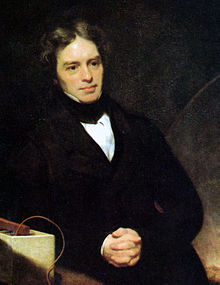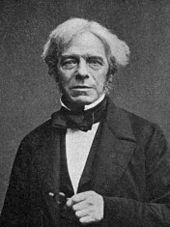Michael Faraday FRS (/ˈfærədeɪ, -di/; 22 September 1791 – 25 August 1867) was an English scientist who contributed to the study of electromagnetism and electrochemistry. His main discoveries include the principles underlying electromagnetic induction, diamagnetism and electrolysis.
Although Faraday received little formal education, he was one of the most influential scientists in history.[1] It was by his research on the magnetic field around a conductor carrying a direct current that Faraday established the basis for the concept of the electromagnetic field in physics. Faraday also established that magnetism could affect rays of light and that there was an underlying relationship between the two phenomena.[2][3] He similarly discovered the principles of electromagnetic induction and diamagnetism, and the laws of electrolysis. His inventions of electromagnetic rotary devices formed the foundation of electric motor technology, and it was largely due to his efforts that electricity became practical for use in technology.[4]
As a chemist, Faraday discovered benzene, investigated the clathrate hydrate of chlorine, invented an early form of the Bunsen burner and the system of oxidation numbers, and popularised terminology such as "anode", "cathode", "electrode" and "ion". Faraday ultimately became the first and foremost Fullerian Professor of Chemistry at the Royal Institution, a lifetime position.
Faraday was an excellent experimentalist who conveyed his ideas in clear and simple language; his mathematical abilities, however, did not extend as far as trigonometry and were limited to the simplest algebra. James Clerk Maxwell took the work of Faraday and others and summarized it in a set of equations which is accepted as the basis of all modern theories of electromagnetic phenomena. On Faraday's uses of lines of force, Maxwell wrote that they show Faraday "to have been in reality a mathematician of a very high order – one from whom the mathematicians of the future may derive valuable and fertile methods."[5] The SI unit of capacitance is named in his honour: the farad.
Albert Einstein kept a picture of Faraday on his study wall, alongside pictures of Arthur Schopenhauer and James Clerk Maxwell.[6] Physicist Ernest Rutherford stated, "When we consider the magnitude and extent of his discoveries and their influence on the progress of science and of industry, there is no honour too great to pay to the memory of Faraday, one of the greatest scientific discoverers of all time."[1]
Michael Faraday | |
|---|---|
 Painting of Faraday (1842) by Thomas Phillips | |
| Born | 22 September, 1791 Newington Butts, England |
| Died | 25 August 1867 (aged 75) Hampton Court, Middlesex, England |
| Known for | Faraday's law of induction Faraday balance Faraday cage Faraday constant Faraday cup Faraday effect Faraday's laws of electrolysis Faraday's ice pail experiment Faraday paradox Faraday paradox (electrochemistry) Faraday rotator Faraday-efficiency effect Faraday wave Faraday wheel Adsorption refrigeration Colloidal gold Homopolar motor Lines of force Magnetic separation MHD converter Premelting Regelation Rubber Balloon |
| Spouse(s) | Sarah Barnard (m. 1821) |
| Awards | Royal Medal (1835 and 1846) Copley Medal (1832 and 1838) Rumford Medal (1846) Albert Medal (1866) |
| Scientific career | |
| Fields | Physics Chemistry |
| Institutions | Royal Institution |
| Influences | Humphry Davy William Thomas Brande |
| Signature | |
https://en.wikipedia.org/wiki/Michael_Faraday


No comments:
Post a Comment